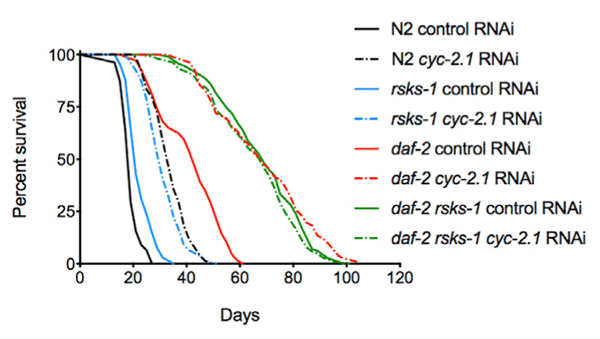
10th January 2020 Longevity breakthrough: 500% increase in nematode lifespan Scientists have identified synergistic cellular pathways for longevity that amplify lifespan fivefold in C. elegans, a nematode worm used as a model in aging research. The research draws on the discovery of two major pathways governing aging in C. elegans. The organism shares many of its genes with human beings and because of its short lifespan – typically only three or four weeks – scientists can quickly assess the effects of genetic and environmental interventions to extend healthy lifespan. Because these pathways are "conserved," meaning they were passed down to humans through evolution, they have been the subject of intensive research. Various drugs that extend healthy lifespan by altering these pathways are already under development. The discovery of the synergistic effect opens the door to even more effective anti-aging therapies. The new research uses a double mutant, in which both the insulin signalling (IIS) and target of rapamycin (TOR) pathways are genetically altered. Since the alteration of the IIS pathways yields a 100% increase in lifespan, and alteration of the TOR pathway yields a 30% increase, the double mutant would be expected to live 130% longer. But instead, its lifespan was amplified by 500%. This increase would be equivalent to a human living for 400 or 500 years, according to one of the scientists.
"Despite the discovery in C. elegans of cellular pathways that govern aging, it hasn't been clear how these pathways interact," said Hermann Haller, M.D., president of the MDI Biological Laboratory in Maine, USA, which collaborated with researchers from the Buck Institute for Research on Aging in Novato, California, and Nanjing University in China. "By helping to characterise these interactions, our scientists are paving the way for much-needed therapies to increase healthy lifespan for a rapidly aging population." "The synergistic extension is really wild," said Jarod Rollins, Ph.D., also from the MDI lab. "The effect isn't one plus one equals two; it's one plus one equals five. Our findings demonstrate that nothing in nature exists in a vacuum. To develop the most effective anti-aging treatments we have to look at longevity networks, rather than individual pathways." The discovery of the synergistic interaction could lead to the use of combination therapies, each affecting a different pathway, to extend healthy human lifespan in the same way that combination therapies are used to treat cancer and HIV, according to Pankaj Kapahi, Ph.D., of the Buck Institute. It may also explain why scientists have been unable to identify a single gene responsible for the ability of some people to live to extraordinary old ages free of major age-related diseases until shortly before their deaths.
Comments »
If you enjoyed this article, please consider sharing it:
|







